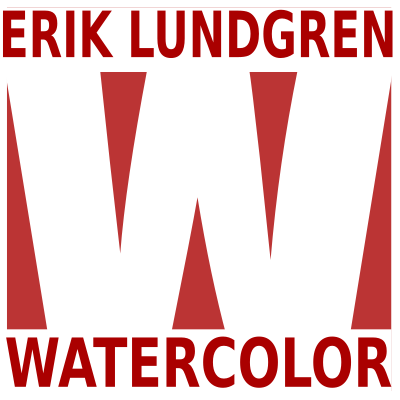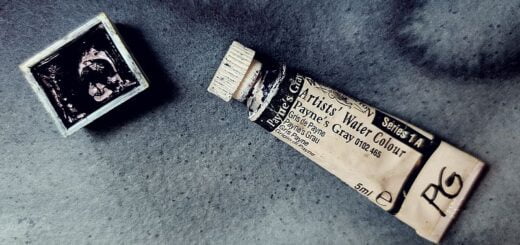Lamp Black | PBk6, PBk7

I know it’s often said that one should not use black watercolor paint. Some even claim that the color is “forbidden.” For me, this is nonsense; of course, you can use whatever colors you want, there are no restrictions on color choices. Among the black watercolors available, lamp black is probably the most common. If a black color is included in a pre-made watercolor set, it’s usually lamp black.
Lamp black is an extremely durable color. It is opaque, usually staining, and very active on wet paper. The color loses much of its value when dry compared to freshly painted, wet color.
The name comes from the fact that the pigment is the same as what could be found on the inside of the burner tube (the glass tube surrounding the gas flame) in old-fashioned gas lamps. This pigment has been made since prehistoric times, though back then with the help of oil lamps.
There are two pigments that are often called lamp black, or sometimes carbon black, namely PBk6 and PBk7, both made from amorphous carbon, carbon atoms that aren’t arranged in a regular pattern. Both have very similar properties and production methods, with PBk6 being the most common pigment for watercolor paint.

The pigment Lamp Black or Carbon Black
4oFK1954, Public domain, via Wikimedia Commons
In addition to being an independent pigment in black watercolor paints, lamp black appears in many mixed colors, ranging from grayish ones like Payne’s gray, neutral tint, and indigo to various brown blends like Sepia, Van Dyke brown, or burnt umber, as well as in many other mixed colors. It’s also quite common for the color to have misleading names like Ivory Black, which is a black color with entirely different properties. Always check the pigment before buying watercolor paint; for lamp black, it should be PBk6 or PBk7.
The paint’s willingness to move on wet paper is one of its most distinctive features, it is very active wet-on-wet. This quality, along with its ability to create an absolutely smooth surface without any hint of granularity, makes it highly suitable for certain applications, especially wet-on-wet with a lot of water.
Personally, I prefer granulated black colors like Ivory Black or Vine Black because I enjoy colors that create interesting textures, but I happily use lamp black when the subject requires smooth transitions in wet-on-wet painting, something that both of the previously mentioned colors struggle to create.
Using black paint in watercolor, as I mentioned earlier, is controversial. Why, I don’t know. All oil painters use black without shame, but watercolor is apparently so refined that it must have rules: no white and no black, but Payne’s gray, Sepia, or Neutral tint are fine, even though they consist of 95% black paint.
I personally like to use black, either to lower the value of other colors or as an independent color if black is part of the painting’s color scheme. For me, black paint is important, and lamp black is useful when wet-on-wet is characteristic of a subject. Its ability to spread evenly and smoothly on wet paper is the reason for this. For more traditional painting, I use Ivory Black or Vine Black instead.




















Just the right info I needed 🙂 Thanks! I am after a black/grey colour that creates smooth wash.